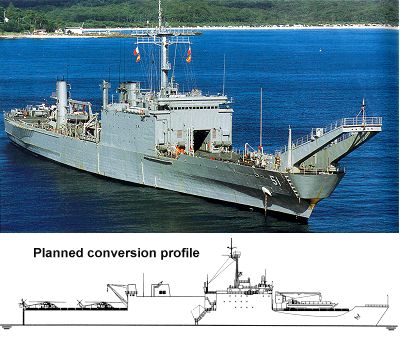

 |
 |
A Short History Before & After Refit:-
by Colin Sheehan
![]()
|
 |
This vessel, with it's sistership HMAS Manoora, was acquired in 1994 from the USN for conversion into amphibious transport and training roles to replace HMA Ships Jervis Bay and Tobruk. Their official designation will then be Training & Helicopter Support Ships (THSS). Their operational condition was soon found to be abysmal with rampant corrosion and much more work & money being needed to complete the job than was anticipated. But that is another story.

Previously named USS Saginaw, it was one of 20 Newport class LST's built for the US Navy. It saw twenty years service before it was mothballed and subsequently purchased by The RAN.
When beaching, it would drop it's stern anchor as it approached and the bows would be opened to enable the large ramps carried on the foredeck to be winched out onto the beach by the large "cowhorns" which form such a noticeable feature of this class of ship. The flat bottom allowed it to approach quite closely, although it did make for stomach lurching voyage sometimes (Especially when running unladen).The "tank deck" occupies the entire length of the ship effectively dividing it into two seperate "ships" with the starboard side housing the 63 WRANS, the port side accommodating the 144 sailors with the machinery space and stores below. It is here that the main load of the LST's would be carried with some also on the main deck. The stern consists of a large door which lowers to provide access to the sea for launching amphibious vehicles. Both ends of the tank deck are fitted with large turntables to rotate the vehicles in preparation for their deployment.
The tunnel visible through the superstructure is to allow the vehicles on the flight deck at the stern to access the ramp. At sea, this makes for a real "wind tunnel" effect which is nice on a hot day, but a killer when the temperature drops.
Click on the photo here for a bigger view of the upper decks as it was pre-conversion.
The operation of the giant derrick and the bow ramp which are used to offload vehicles to a beach or shore destination can be clearly seen in action here as a truck is driven ashore from the USS Saginaw.
The refitted vessel, with her sister ship HMAS Manoora, adds much needed logistic support to the RAN's fleet and the Australian Defence Forces in general. The most noticeable changes are the addition of the large hanger midships which houses 4 Seahawk or 3 SeaKing helo's and the removal of approximately 70 tonnes of dead weight on the bows in the form of the very distinctive 34 m bowramp and gantry. Added to this is a widening and flaring of the bows to give more usable deck space and the fitting of non-opening bows. Aft, by clearing the deck and extending it's length 12 metres and raking the stern, the helicopter capability has been enhanced even with the addition of the hangar. When the two LCM8s are not onboard, the forward deck has the capability to handle one helo as well. Vehicular access from the tank deck and is via the ramp to the forward flight deck or through the stern door to other amphibious craft.
On the port side, the boat deck will accomodate two 7.2m RHIBs (Rigid Hull Inflatable Boats).
The ship will have an enhanced Command, Control and Communications (C3) capability which would allow good support for any force commanders embarked or as a valuable central control point in the event of emergency support. Medical facilities have been added to include pre and post operative beds and two operating tables. 6 bed intensive care and 32 bed low dependency wards with x-ray and surgical equipment are also fitted.
Steam based systems such as heating, cooking and watermaking have been replaced with electric powered systems to improve efficiency. Upgraded power generation will cover this extra load. Three dual use compartments have been added to provide a classroom/briefing room that seats 26, a chartroom with 15 workstations and a general purpose room with 10 further workstations. These last two could be used for command and control areas for embarked amphibious forces or general training whilst at sea.
|
|
Day 1 |
Day 2 |
|
Day 3 |
Day 3 Pt.II |
|
| The Refit | Short History |